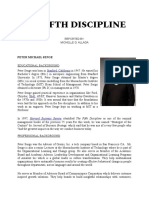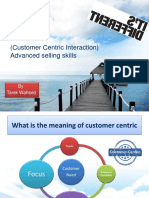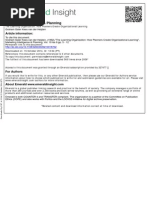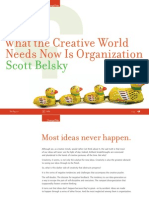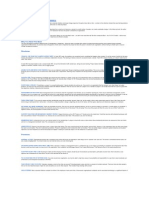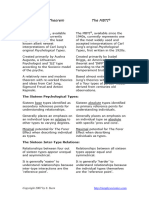Fifth Discipline
Fifth Discipline
Uploaded by
Amit RajCopyright:
Available Formats
Fifth Discipline
Fifth Discipline
Uploaded by
Amit RajCopyright
Available Formats
Share this document
Did you find this document useful?
Is this content inappropriate?
Copyright:
Available Formats
Fifth Discipline
Fifth Discipline
Uploaded by
Amit RajCopyright:
Available Formats
Fifth Discipline
This Book is Divided Into 5 Parts
And First Part Of this book talks about “How Our Actions Create Our Realty and How
We Can Change it”.
Learning organization-The ability to learn faster than your competitors,"
Royal Dutch/Shell, " Said in this chapter that “As the world becomes more
interconnected and business becomes more complex and dynamic, work must
become more learningful.”
DISCIPLINES OF THE LEARNING ORGANIZATION\
After 1903 when Wright brothers found powered flight is possible but it
takes 30 years when commercial flight is possible.
“Basic Innovation”: - The innovation are Sufficiently important, such as the
telephone, the digital computer, or commercial aircraft, it is called a "basic
innovation,".
Component Technology :- when Idea become invention to innovation
McDonnell Douglas DC-3 1935
myriad experiments with commercial flight had failed. Like early
experiments with learning organizations, the early planes were not reliable
and cost effective on an appropriate scale.
The DC-3brought together five critical component technologies
They were:
1. the variable-pitch propeller,
2. retractable landing gear,
3. a type of lightweight molded body construction called "monocque,"
4. radial air-cooled engine,
5. wing flaps
For plane all 5 components are required earlier in boing 247 it not have wing
flaps so boing 247 struggle during take-off and landing
cloud masses, the sky darkens, leaves twist upward, and we
know that it will rain. These all are connected with each other
You can only understand the system of a rainstorm by
contemplating the whole, not any individual part of the pattern.
Business and other human endeavours are also systems. They, too, are bound
by invisible fabrics of interrelated actions,
Systems thinking is a conceptual framework, a body of
knowledge and tools that has been developed over the past fifty years, to
make the full patterns clearer, and to help us see how to change them
effectively.
experiments with young children show that they learn systems thinking very
quickly.
Personal Mastery_ People with a high level of personal mastery are able to
consistently realize the results that matter most deeply to them— in effect,
they approach their life as an artist would approach a work of art. They do
that by becoming committed to their own life long learning.
Personal mastery is essential for learning organisation
It is important for all organisation to support in learning organisation
Mental Models. Is all about how we understand the world and how we take
action ‘
For example someone who dresses shabbily, we may feel, "He doesn't care
about what others think.
Royal Dutch/Shell, they discovered how pervasive was the influence of
hidden mental models, especially those that become widely shared.
Arie de Geus, Shell's recently retired Coordinator of Group Planning, says
that continuous adaptation and growth in a changing business environment
depends on "institutional learning, which is the process whereby
management teams change their shared mental models of the company,
their markets, and their competitors.
mental models starts with turning the mirror
inward; learning to unearth our internal pictures of the world, to bring them
to
the surface and hold them rigorously to scrutiny.
Building Shared Vision. many leaders have personal visions that never get
translated into shared visions that galvanize an organization a crisis that
galvanizes everyone temporarily but most people opt for pursuing a lofty
goal, not only in times of crisis but at all times. Skills of unearthing shared "pictures of
the future" that foster genuine commitment and enrolment rather than compliance. In
mastering this discipline, leaders learn the counter productiveness of trying to
dictate a vision, no matter how heartfelt.
Team Learning. The discipline of team learning starts with "dialogue," the
capacity of members
of a team to suspend assumptions and enter into a genuine "thinking
together."
Greeks dia-logos meant allowing the group to discover insights not attainable
individually
Now the meaning of dialog is different (Dialogue differs from the more
common "discussion," which has its roots with "percussion" and
"concussion,"
"the rubber meets the road";
If a learning organization were an engineering innovation, such as the
airplane or
the personal computer, the components would be called "technologies."
Here author talks about discipline discipline," I do not mean an "enforced
order" or "means of punishment," but a
body of theory and technique that must be studied and mastered to be put into
practice.
Some people have but some can master it by practice
Practicing a discipline is different from emulating "a model."
Fifth Discipline
It is the discipline that
integrates the disciplines, fusing them into a coherent body of theory and
practice. It keeps them from being separate gimmicks or the latest
organization change fads. Without a systemic orientation, there is no
motivation to look at how the disciplines interrelate.
Ending the war between work and family
How can personal mastery and learning flourish At work and at home?
Research said 36 percent of the children of executives undergo treatment for
psychiatric or drug abuse each year, vs. 15 percent of children of non-
executives in the same companies.
The author counselled that high-powered managers need to learn how to
boost their children's "self-esteem." But the rest of them, simply accepts the
fact that work inevitably conflicts with family life, and that the organization
has no part to play in improving imbalances between work and family.
Some organisation simply said "If you want to get ahead here, you must be
willing to make sacrifices." Some demand slike spending times on weekend
These all pressures arise primarily from the narrow focus on organizational
goals. And as we know The learning organization cannot support personal
mastery without supporting personal mastery in all aspects of life. We all
have to make a artificial boundary work and family
THE STRUCTURE OF WORK/FAMILY IMBALANCE
He found that "Success to the Successful" it consists of two
reinforcing growth processes, each of which tend to fuel increasing levels of
success he said
reinforcing (amplifying) growth of time
and commitment in one's work: more time leads to greater success,
reinforcing growth of time and commitment at home: more time at home
leads to
more "success"
"Success to the Successful" archetype is
intrinsically unstable. Once it starts to drift one way or another, it will tend to
continue to drift. there are several reasons why it tends to drift toward more
and more time at work. First, there is the matter of income. If time at work
falls
too far, income falls and creates pressure for more time at work. Secondly,
the reinforcing "time
at home" process tends to be especially strong in the negative, "vicious
spiral"
direction.
dominant reinforcing feedback in "Success to the Successful," the
imbalances are not self-correcting. Indeed, they grow worse and worse over
time. This is why work-family issues are so vexing.
THE INDIVIDUAL'S ROLE
is really your vision to have a balance between work and family. Making a
conscious choice will entail setting clear personal goals for time at
home.
In some organizations, managers may pay a price in their career opportunities
if
they take a stand for a vision of balance between work and family
principles of personal mastery and enrollment:
• Identify what is truly important to you
• Make a choice (commitment)
• Be truthful with those around you regarding your choice
• Do not try to manipulate them into agreement or superficial sup port
You might also like
- The Fifth DisciplineDocument15 pagesThe Fifth DisciplineZau Seng50% (2)
- The 5th DisciplineDocument9 pagesThe 5th DisciplineSuman Poudel50% (4)
- The Fifth Discipline: The Art and Practice of The Learning OrganizationDocument20 pagesThe Fifth Discipline: The Art and Practice of The Learning Organizationicecreami100% (7)
- Hidden - Value The Book PDFDocument296 pagesHidden - Value The Book PDFDaniel CiNo ratings yet
- The Fifth Discipline: Peter Michael SengeDocument7 pagesThe Fifth Discipline: Peter Michael SengeMichelle Gonzales Allaga-Vicente100% (1)
- Inservice EducationDocument49 pagesInservice Educationprabha krishnan88% (25)
- #Advanced Selling Skills - Tarek Wahed PDFDocument63 pages#Advanced Selling Skills - Tarek Wahed PDFNour Gafar100% (1)
- Ending The War Between Work and FamilyDocument5 pagesEnding The War Between Work and FamilyAmit RajNo ratings yet
- Peter M. Senge - : Making A Better WorldDocument5 pagesPeter M. Senge - : Making A Better Worldzetabro1No ratings yet
- The Learning Organization - How Planners Create Organizational Learning PDFDocument11 pagesThe Learning Organization - How Planners Create Organizational Learning PDFvlademiroNo ratings yet
- 6 - ORGANIZATION AND ITS ENVIRONMENT (The Learning Organization and Its Future-2) - Tin BautroDocument17 pages6 - ORGANIZATION AND ITS ENVIRONMENT (The Learning Organization and Its Future-2) - Tin BautroDARLENENo ratings yet
- Sarahbeth Gareis Ogl 340 Final 20211008Document7 pagesSarahbeth Gareis Ogl 340 Final 20211008api-594507221No ratings yet
- What Is Creative Leadership?: Creative Problem-Solving MovementDocument7 pagesWhat Is Creative Leadership?: Creative Problem-Solving MovementamitsinghbdnNo ratings yet
- Practice of InnovationDocument4 pagesPractice of Innovationankitrathod87No ratings yet
- Behavior Over Time GraphsDocument8 pagesBehavior Over Time Graphsmanisha_bhavsarNo ratings yet
- Working With ComplexityDocument7 pagesWorking With ComplexitychoileoNo ratings yet
- Managing Innovation Chapter 3Document67 pagesManaging Innovation Chapter 3cutadeNo ratings yet
- Week 3 - Reading - Reinventing - Management - Extract1 PDFDocument7 pagesWeek 3 - Reading - Reinventing - Management - Extract1 PDFLavinia DinuNo ratings yet
- The Power of Professional Closeness: A Guide to Taking a Holistic Approach to Your BusinessFrom EverandThe Power of Professional Closeness: A Guide to Taking a Holistic Approach to Your BusinessNo ratings yet
- 1 - Five Dis-Seven DisabilitiesDocument44 pages1 - Five Dis-Seven Disabilitiessohaibkhan73No ratings yet
- Discipline: Art and Practice of The Learning OrganizationDocument9 pagesDiscipline: Art and Practice of The Learning OrganizationAlexandruSimionNo ratings yet
- Challenges Developing Learning OrgDocument6 pagesChallenges Developing Learning OrgWan Sek ChoonNo ratings yet
- Organizational Behavior Assignment "Team Building": Teams in The Modern WorkplaceDocument6 pagesOrganizational Behavior Assignment "Team Building": Teams in The Modern WorkplaceZiauddin ZiaNo ratings yet
- Lead More, Control Less: 8 Advanced Leadership Skills That Overturn ConventionFrom EverandLead More, Control Less: 8 Advanced Leadership Skills That Overturn ConventionNo ratings yet
- What The Creative World Needs Now Is Organization: Scott BelskyDocument12 pagesWhat The Creative World Needs Now Is Organization: Scott Belskyapi-26120322No ratings yet
- Cosc4151 Systems Simulation and ModelingDocument25 pagesCosc4151 Systems Simulation and ModelingsaviodevNo ratings yet
- Concept QuestionsDocument16 pagesConcept Questionsdaniel nduatiNo ratings yet
- Teamwork Thesis PDFDocument4 pagesTeamwork Thesis PDFKristen Carter100% (3)
- Motivation at WorkDocument10 pagesMotivation at WorkCoach NishaNo ratings yet
- Principales Principios de ADMDocument3 pagesPrincipales Principios de ADMDcapdevilaNo ratings yet
- Disruptive Ideas LeandroherreroDocument6 pagesDisruptive Ideas LeandroherreroDiego J. Carmona A.No ratings yet
- Case Study'sDocument18 pagesCase Study'sSania Jabeen Sania JabNo ratings yet
- McKinsey Change Leader Change ThyselfDocument11 pagesMcKinsey Change Leader Change ThyselftheglobalcaNo ratings yet
- Reframing OrganizationsDocument5 pagesReframing OrganizationsFlavia Carolina Jorquera OrtuzarNo ratings yet
- The Fifth Discipline: The Art and Practice: ReviewsDocument4 pagesThe Fifth Discipline: The Art and Practice: ReviewsveriaryantoNo ratings yet
- Wisnu Subekti, 2022. Evaluation of A Community of Practice at Holden CollegeDocument17 pagesWisnu Subekti, 2022. Evaluation of A Community of Practice at Holden CollegeWisnu SubektiNo ratings yet
- Organiztional Behaviour - Textbook and Cases Indian AuthorsDocument327 pagesOrganiztional Behaviour - Textbook and Cases Indian Authorsatulaherwar100% (3)
- Teamwork: (Charles L. Parnell Speech)Document6 pagesTeamwork: (Charles L. Parnell Speech)Rajesh SoniNo ratings yet
- Synergy ManagmentDocument17 pagesSynergy ManagmentPrincess Chan delos ReyesNo ratings yet
- Fast/Forward: Make Your Company Fit for the FutureFrom EverandFast/Forward: Make Your Company Fit for the FutureRating: 5 out of 5 stars5/5 (1)
- Destination Innovation: HR's Role in Charting the CourseFrom EverandDestination Innovation: HR's Role in Charting the CourseNo ratings yet
- Finding the Missing Pieces: How to Solve the Puzzle of Digital Modernization and TransformationFrom EverandFinding the Missing Pieces: How to Solve the Puzzle of Digital Modernization and TransformationNo ratings yet
- Learning OrganizationDocument15 pagesLearning OrganizationHaroon RasithNo ratings yet
- Organizational Theory Term PaperDocument4 pagesOrganizational Theory Term PaperCustomNotePaperUK100% (1)
- Group Assignment QualityDocument15 pagesGroup Assignment QualityCarlos Andres GualdronNo ratings yet
- Collaborate For RealDocument5 pagesCollaborate For RealParthasarthy SkNo ratings yet
- Antoine de Saint-Exupéry: Who'S The BossDocument3 pagesAntoine de Saint-Exupéry: Who'S The BossNicoletaNo ratings yet
- Running Head: (Script) 1: Innovation in The WorkplaceDocument12 pagesRunning Head: (Script) 1: Innovation in The WorkplaceNunya BizNo ratings yet
- Running Head: Practicing Organizational Citizenship 1Document7 pagesRunning Head: Practicing Organizational Citizenship 1Bee RodNo ratings yet
- Entrepreneurial Habits: Anagement Is Doing Things Right Leadership Is Doing The Right ThingsDocument8 pagesEntrepreneurial Habits: Anagement Is Doing Things Right Leadership Is Doing The Right ThingsIrish Nicole RouraNo ratings yet
- Empower! to Win: An Action Guide to the Imperative Leadership Style of the 21St CenturyFrom EverandEmpower! to Win: An Action Guide to the Imperative Leadership Style of the 21St CenturyNo ratings yet
- A Joosr Guide to... An Everyone Culture by Robert Kegan and Lisa Laskow Lahey: Becoming a Deliberately Developmental OrganizationFrom EverandA Joosr Guide to... An Everyone Culture by Robert Kegan and Lisa Laskow Lahey: Becoming a Deliberately Developmental OrganizationNo ratings yet
- The Fifth Discipline: The Art & Practice of The Learning OrganizationFrom EverandThe Fifth Discipline: The Art & Practice of The Learning OrganizationNo ratings yet
- Richard BransonDocument43 pagesRichard BransonAnanth Krishnan50% (2)
- Employee Motivation: A Powerful New Model: by Nitin Nohria, Boris Groysberg, and Linda-Eling LeeDocument6 pagesEmployee Motivation: A Powerful New Model: by Nitin Nohria, Boris Groysberg, and Linda-Eling LeeDavid SaldivarNo ratings yet
- UntitledDocument3 pagesUntitledLakshan SandaruwanNo ratings yet
- GHS05 - Organization and Management For Week 13 and Week 14 of 20 (Assignment)Document7 pagesGHS05 - Organization and Management For Week 13 and Week 14 of 20 (Assignment)Micol Villaflor ÜNo ratings yet
- Claims - LIDocument44 pagesClaims - LIAmit RajNo ratings yet
- Marketing Plan On FevicolDocument18 pagesMarketing Plan On FevicolAmit RajNo ratings yet
- GST Material - 1.3.21Document10 pagesGST Material - 1.3.21Amit RajNo ratings yet
- IIRM PGDM Session 1 Ice Breaking PDFDocument41 pagesIIRM PGDM Session 1 Ice Breaking PDFAmit RajNo ratings yet
- JPG 2 PDFDocument3 pagesJPG 2 PDFAmit RajNo ratings yet
- Six Years of DemonetisationDocument4 pagesSix Years of DemonetisationAmit RajNo ratings yet
- Why CanDocument2 pagesWhy CanAmit RajNo ratings yet
- It Is 2002Document3 pagesIt Is 2002Amit RajNo ratings yet
- Basic Concepts Latest - 10.12.22Document25 pagesBasic Concepts Latest - 10.12.22Amit RajNo ratings yet
- Facts About Loans and Credit CardDocument1 pageFacts About Loans and Credit CardAmit RajNo ratings yet
- Analyzing Consumer MarketDocument25 pagesAnalyzing Consumer MarketAmit RajNo ratings yet
- John DooleyDocument1 pageJohn DooleyAmit RajNo ratings yet
- Millennial EmploymentDocument10 pagesMillennial EmploymentAmit RajNo ratings yet
- Marketing AssignmentDocument10 pagesMarketing AssignmentAmit RajNo ratings yet
- Chapter 12 To 15Document3 pagesChapter 12 To 15Amit RajNo ratings yet
- Adani Group Want To Invest in Education SectorDocument15 pagesAdani Group Want To Invest in Education SectorAmit RajNo ratings yet
- Case Study-ADocument8 pagesCase Study-AAmit RajNo ratings yet
- Socionics Vs Mbti Spencer SternDocument5 pagesSocionics Vs Mbti Spencer Sternkerber.horusNo ratings yet
- IronyDocument2 pagesIronyM Sohail KhanNo ratings yet
- SarokDocument1 pageSaroktheartisanspen.mspcNo ratings yet
- Effects of Infrared Radiation in The Treatment of Patients With Knee OsteoarthritisDocument10 pagesEffects of Infrared Radiation in The Treatment of Patients With Knee OsteoarthritisMARÍA TERESA HERNÁNDEZ HUERTANo ratings yet
- Give An Account of The Tribes Living in Madina and The Details of The Constitution of Madina That Brought Them All TogetherDocument2 pagesGive An Account of The Tribes Living in Madina and The Details of The Constitution of Madina That Brought Them All TogetherSaima SyedNo ratings yet
- Indicate The Underlined Part As Linguistic StructuresDocument3 pagesIndicate The Underlined Part As Linguistic StructuresNguyễn Thị Ánh Tuyết0% (1)
- Hemodialysis Seperation ProcessDocument7 pagesHemodialysis Seperation Processchen18111007 KFUEITNo ratings yet
- Species Limits in Antbirds (Thamnophilidae)Document19 pagesSpecies Limits in Antbirds (Thamnophilidae)Andy ArccoNo ratings yet
- Field NotesDocument3 pagesField NotescartershannonNo ratings yet
- Aryan (Hero Honda Karizma ZMR)Document22 pagesAryan (Hero Honda Karizma ZMR)Anshul SharmaNo ratings yet
- Comment 1570 Plea BargainingDocument2 pagesComment 1570 Plea BargainingNiño DauzNo ratings yet
- Apps DBA Workshop - Oracle Apps R12.1Document32 pagesApps DBA Workshop - Oracle Apps R12.1anil0486No ratings yet
- Stokes, Arabesk DebateDocument5 pagesStokes, Arabesk DebateMark TrentonNo ratings yet
- AR253 History 2 - Structuralism and MetabolismDocument55 pagesAR253 History 2 - Structuralism and MetabolismianNo ratings yet
- Indian Film Making Class NotesDocument2 pagesIndian Film Making Class NotesabhishekrayabarapuNo ratings yet
- Chapter 14 Section 1 NotesDocument2 pagesChapter 14 Section 1 NotesJiayan WNo ratings yet
- Part 12 - Grade 1 Edumate Music LP - Curwen Hand SignDocument4 pagesPart 12 - Grade 1 Edumate Music LP - Curwen Hand SignAndrewOribianaNo ratings yet
- Case Digest Verceles Vs COADocument10 pagesCase Digest Verceles Vs COAMaricar TegeroNo ratings yet
- 138 Notice-Manoj ParveDocument3 pages138 Notice-Manoj ParvemanojNo ratings yet
- 007-013502-001 - Microsoft Identity Manager 2016 - Integration Guide - RevA PDFDocument34 pages007-013502-001 - Microsoft Identity Manager 2016 - Integration Guide - RevA PDFcongthangNo ratings yet
- Oral Reading Fluency ParentDocument2 pagesOral Reading Fluency Parentapi-232689781No ratings yet
- R8047e Mcaa 11Document24 pagesR8047e Mcaa 11Rinda_RaynaNo ratings yet
- Grade 5 MathematicsDocument5 pagesGrade 5 MathematicsJoseph Andey100% (1)
- Thesis Statement For Hamlet As A Tragic HeroDocument8 pagesThesis Statement For Hamlet As A Tragic Herotit0feveh1h3100% (1)
- Chapter 10Document5 pagesChapter 10Linh NguyenNo ratings yet
- Kundun Movie AnalysisDocument2 pagesKundun Movie Analysisapi-299092971100% (1)




